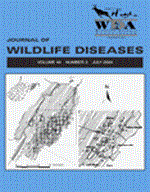The nonindigenous Barbary sheep population (Ammotragus lervia) of the Sierra Es back. The density of Barbary sheep in the Sierra puña Regional Park (Murcia, Spain) suffered an outbreak of sarcoptic mange between 1991 and 1995, which contributed to a population decrease of 86%. This study presents the results of two population surveys conducted in 1994 and 1999 based on the fixed point and itineraries method (FPI) and the excrement count (EC) method, as well as data from demographic estimates and clinical observations conducted by the Regional Administration of Murcia. Results of surveillance for mange are given between 1992 and 1995, because no animals were observed with sarcoptic mange in 1999. Prevalence of mange peaked in 1994 and then declined. During the regression phase of the epidemic, there was a higher infection rate in males (21.9%) than in females (16.6%) or young animals (5.1%). Males over 5 yr old were the worst affected age group, followed by subadults of both sexes. Few animals had generalized lesions of mange (7%), and most individuals (72%) had lesions of moderate severity. The most common locations of lesions were the neck, head, and back. The density of Barbary sheep in the Sierra Espuña Regional Park increased from introduction in 1972 until it peaked at 13 animals/km in 1991, the year when the first case of sarcoptic mange was detected. After 2 yr of the mange epidemic, the average estimated density was 1.7 animals/km2 in 1994, which increased to 5.0 animals/km2 in 1999. The average group size also increased from 7.9 to 19.2 animals/group between 1994 and 1999. The sex ratio, expressed as the proportion of females in the total population observed, decreased from 0.61 in 1994 to 0.49 in 1999. The reproduction rate (kids per females per year) was essentially stable (0.59 in 1994 to 0.65 in 1999). Between 1994 and 1999 the population aged, with the number of young animals (<18 mo of age) decreasing from 45.3% to 36.6% from 1994 to 1999. In the same period, the proportion of males increased 21.4% to 32.6%. We believe sarcoptic mange acted as one of the regulating factors of population density after 1991 and that currently, although no sarcoptic mange lesions were observed in the 1999 survey, there is a demographic imbalance in sex ratio, age structure, and density.
How to translate text using browser tools
1 July 2004
POPULATION EFFECTS OF SARCOPTIC MANGE IN BARBARY SHEEP (AMMOTRAGUS LERVIA) FROM SIERRA ESPUÑA REGIONAL PARK, SPAIN
Mónica González-Candela,
Luis Léon-Vizcaíno,
María José Cubero-Pablo

Journal of Wildlife Diseases
Vol. 40 • No. 3
July 2004
Vol. 40 • No. 3
July 2004
Ammotragus lervia
Barbary sheep
demography
epidemiology
Sarcoptes scabiei
sarcoptic mange




